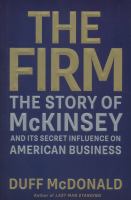Book Reviews: McKinsey and Goldman Sachs
During the course of their careers, most Fuqua students will either find employment within the fields of consulting or finance, or they will work in industries that are profoundly affected by those professions. Two engaging new books in the Ford Library are about the leading companies in those fields, McKinsey and Goldman Sachs.
 The Firm : the story of McKinsey and its secret influence on American business by Duff McDonald. McKinsey & Co. is one of the most influential companies in the world, a firm that is woven into decision making at the highest levels in business and government. Business journalist Duff McDonald explores the company and its history, showing how McKinsey consultants shaped the concept of American capitalism, promoted the use of scientific approaches to business management, and served as a catalyst for change.
The Firm : the story of McKinsey and its secret influence on American business by Duff McDonald. McKinsey & Co. is one of the most influential companies in the world, a firm that is woven into decision making at the highest levels in business and government. Business journalist Duff McDonald explores the company and its history, showing how McKinsey consultants shaped the concept of American capitalism, promoted the use of scientific approaches to business management, and served as a catalyst for change.
McDonald begins his book when the company is established in 1926 and he shows how the company evolves with changes in company leadership and the shifting environment of business. McKinsey quickly achieves success at using problems in corporations as its own profit opportunity, providing advice and developing tools to solve them. Yet McDonald is ambivalent about the benefit of its advice to corporate executives. While he documents the sophisticated work performed by the firm, he also provides numerous examples of bad advice that resulted in spectacular failures (General Motors, Enron, Swissair). Also available as a Kindle e-book.
 What Happened to Goldman Sachs? : an insider’s story of organizational drift and its unintended consequences by Steven G. Mandis. In his memoir, Why I Left Goldman Sachs, (reviewed here) Greg Smith wrote that somewhere between 2000 and 2012, Goldman lost its way and its culture of truthfulness and collaboration changed to one of generating optimum profits for the partners. In a new book, What Happened to Goldman Sachs, former Goldman trader Steven Mandis analyzes why Goldman’s culture drifted.
What Happened to Goldman Sachs? : an insider’s story of organizational drift and its unintended consequences by Steven G. Mandis. In his memoir, Why I Left Goldman Sachs, (reviewed here) Greg Smith wrote that somewhere between 2000 and 2012, Goldman lost its way and its culture of truthfulness and collaboration changed to one of generating optimum profits for the partners. In a new book, What Happened to Goldman Sachs, former Goldman trader Steven Mandis analyzes why Goldman’s culture drifted.
In 1979, Goldman was a privately owned firm with 1000 employees and revenues of $100 million. Senior partner John Whitehead codified written principles, those already in use throughout the company to ensure that employees put the client first. By 2006, Goldman was public with a goal of becoming the world’s dominant investment bank, with 25,000 employees and $10 billion in revenues. In his insightful book, Mandis evaluates the complicated reasons that Goldman drifted from its high ethical principle of service to their clients to a legal standard, an ambiguous line with the potential for conflict of interests. He concludes that competitive pressures and pursuit of growth will foster additional drift from Goldman’s principles despite public outcry and disappointment among clients.
© Reviewer: Meg Trauner & Ford Library – Fuqua School of Business.
All rights reserved.